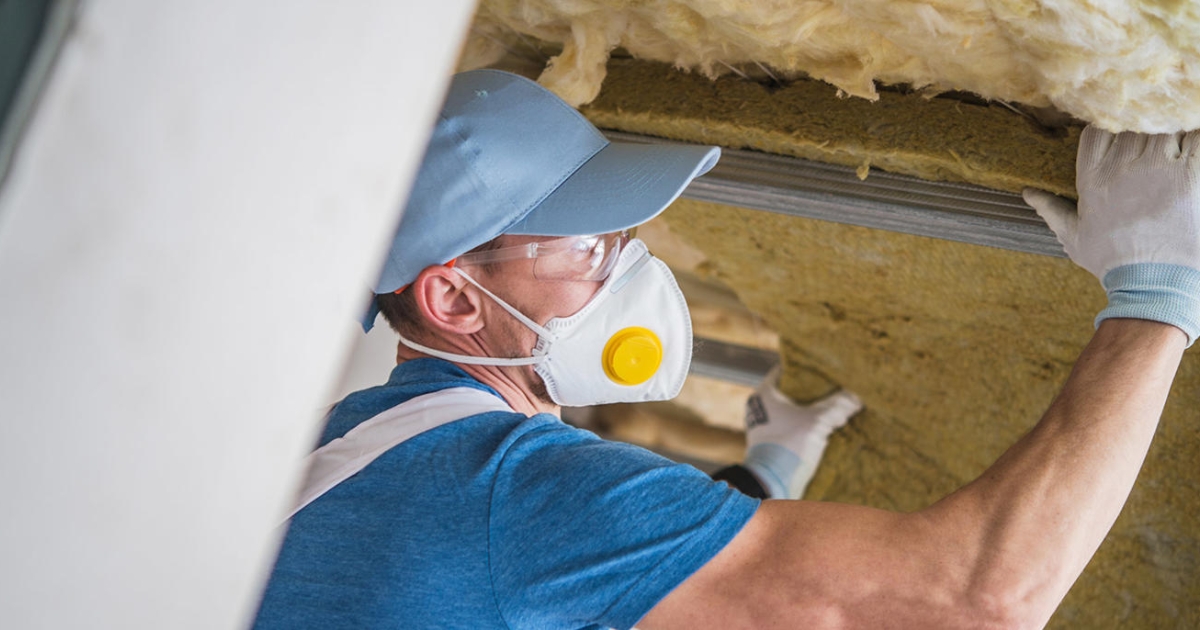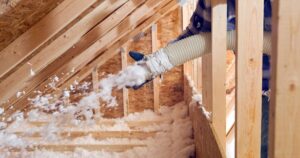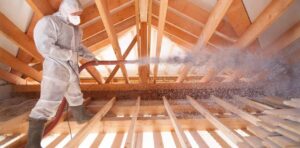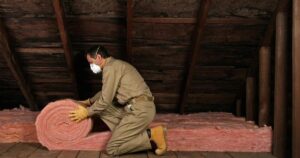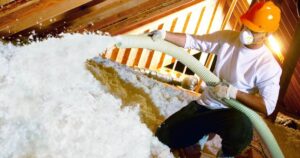Insulating your home is a surefire way to ensure warmth and coziness in all your rooms, especially during colder seasons. Proper insulation involves sealing air leaks, adding insulation to walls, attics, and floors, and using energy-efficient windows and doors. By investing in insulation, you create a barrier that helps maintain a comfortable temperature throughout your home.
Proper insulation not only keeps your home warm but also reduces energy bills by preventing heat loss, making it an eco-friendly choice. There are various types of insulation available, such as fiberglass, cellulose, foam, and more, each with its unique benefits and installation methods.
Insulating your loft
One crucial area to insulate in your home is the loft. Insulating the loft helps to prevent heat from escaping through the roof and keeps your home warm in winter. This process involves laying insulation between and over the floor joists in the loft, creating a barrier that reduces heat transfer and maintains a comfortable temperature inside your house.
Whether using mineral wool, rigid foam, or other insulation materials, ensuring that the loft is properly insulated can significantly impact your energy efficiency and heating costs. It’s an effective way to make your home more comfortable while also contributing to a greener environment by reducing energy consumption.
DIY or ask an expert?
When considering insulation, the decision to DIY or hire a professional depends on various factors such as the type of insulation, the area you plan to insulate, and your expertise. While DIY insulation projects can be cost-effective, some areas might require specialized skills or equipment that professionals can efficiently handle.
Experts not only ensure proper installation but can also offer advice on the best insulation for your home, potentially saving you from costly mistakes. However, if you opt for a DIY approach, ensure you follow safety measures and installation guidelines provided by manufacturers to achieve optimal insulation and comfort in your home.
What do you use?
Choosing the right insulation material is crucial in achieving an effectively insulated home. Factors like the R-value (the insulation’s ability to resist heat flow), the area you’re insulating, and any specific needs, such as fire resistance or eco-friendliness, play a significant role in selecting the appropriate insulation material.
Common materials like fiberglass, cellulose, foam, and mineral wool each have their advantages and disadvantages. For instance, foam insulation might be more expensive but provides better sealing against air leaks, while fiberglass is cost-effective and relatively easy to install. Assessing your home’s needs and consulting with professionals can help you make an informed decision on the type of insulation to use.
Insulation cools your home in summer too
Insulation not only keeps your home warm in the winter but also helps to maintain a cooler temperature during the summer. Proper insulation acts as a barrier against outside heat, preventing it from seeping into your home, thereby reducing the need for excessive air conditioning.
By effectively insulating your home, you create a more consistent and comfortable indoor environment year-round, reducing the reliance on air conditioning systems and subsequently cutting down on energy costs. This dual benefit of insulation makes it a smart investment for maintaining a comfortable living space throughout the changing seasons.
Seven Other Practical Tips to Reduce Energy Bills
Apart from insulation, several other practical tips can help in reducing energy bills and maintaining a comfortable home. Draught proofing, using thermostats or smart thermostats, and investing in thermal curtains and blinds are effective ways to regulate temperature and minimize energy wastage in your home.
1. Draught Proofing
Sealing gaps around windows, doors, and pipes to prevent cold air from entering and warm air from escaping is an easy and cost-effective way to reduce energy consumption. Simple measures like using weather stripping or caulking can effectively eliminate drafts, keeping your home snug.
2. Thermostats and Smart Thermostats
Installing programmable thermostats or smart thermostats can help in regulating temperatures efficiently, allowing you to adjust heating or cooling based on your schedule. These devices optimize energy usage, saving you money while maintaining comfort.
How Hot Is Too Hot?
Understanding the optimal temperature settings for your heating system is crucial. Balancing comfort and energy efficiency involves setting thermostats to avoid excessive heat, thereby reducing energy waste.
Heating Controls Using Thermostatic Radiator Valves
Thermostatic radiator valves provide individual control over the heating in different rooms, allowing for personalized temperature settings. This control mechanism enhances energy efficiency by heating only the necessary spaces.
3. Home Décor Thermal Curtains and Blinds
Using thermal curtains or blinds helps in insulating windows, preventing heat loss in winter and heat gain in summer. These add a decorative touch while serving as a functional energy-saving solution.
More Energy Saving Home Improvements
Alongside insulation, other home improvements like double glazing, new boilers or heat pumps, wall and floor insulation, and secondary glazing contribute significantly to reducing energy consumption.
4. Double Glazing
Double-glazed windows provide better insulation by creating a barrier between indoor and outdoor temperatures, reducing heat transfer and noise.
Secondary Glazing
Secondary glazing involves adding an additional slim window inside the existing one, further enhancing insulation and reducing noise while maintaining the aesthetic appeal of your home.
5. A new boiler or heat pump
Upgrading to a new, energy-efficient boiler or heat pump can drastically reduce energy consumption while providing effective heating and hot water, contributing to both comfort and cost savings.
6. Wall Insulation
Insulating walls helps in reducing heat loss and maintaining a consistent indoor temperature. Materials like cavity wall insulation or solid wall insulation contribute to improved energy efficiency.
7. Floor Insulation
Insulating floors, especially over unheated spaces like garages or basements, helps retain heat, making the living areas more comfortable while cutting down on energy usage.
More Energy Saving Home Improvements
In addition to insulation, several other energy-saving improvements significantly impact a home’s overall energy efficiency. Upgrading to double-glazed windows can minimize heat loss and noise infiltration, offering a more comfortable living space while reducing the need for excessive heating or cooling.
Investing in a new, energy-efficient boiler or heat pump is a substantial long-term investment that can substantially reduce energy consumption. Moreover, wall and floor insulation play pivotal roles in maintaining consistent indoor temperatures and cutting down on heating and cooling costs.
Further Information on Grant Funding and Free Advice on Energy Efficiency Measures
Seeking additional information on grant funding and free advice on energy efficiency measures is highly recommended. Many regions offer grants, rebates, or financial assistance for homeowners looking to make energy-efficient upgrades. Consulting with energy advisors or local authorities can provide valuable insights and guidance regarding available grants and the most suitable energy-efficient measures for your home.
External wall insulation creates a more attractive, warmer, and quieter home
External wall insulation not only enhances the aesthetics of your home but significantly contributes to a warmer and quieter living environment. By providing an additional layer of insulation on the outside, it minimizes heat loss and noise intrusion, resulting in a more comfortable and serene home.
Implementing external wall insulation is a long-term investment that not only adds value to your property but also reduces your energy consumption, positively impacting your overall utility costs.
As energy bills rise, it’s time to get insulating
In the face of increasing energy costs, the importance of insulating your home cannot be overstated. Opting for insulation not only keeps your home comfortable year-round but also acts as a robust solution to counterbalance the ever-increasing energy expenses.
It’s crucial for homeowners to acknowledge the role of insulation in reducing carbon emissions and lessening the strain on household finances. Insulation is an effective, long-term strategy to create a more sustainable and cost-efficient home.
Insulating your loft
Focusing on insulating your loft area is a strategic move in making your home more energy-efficient. Insulating the loft space not only retains heat within your home but also prevents heat from escaping through the roof. Proper insulation in this area plays a crucial role in maintaining a consistently comfortable temperature inside your house, particularly during colder months.
Loft insulation materials can vary, including options such as mineral wool, rigid foam, or blown cellulose. The choice of material depends on factors like effectiveness, cost, and ease of installation. By ensuring the loft is well-insulated, you create a thermal barrier that positively impacts your energy bills and overall home comfort.
DIY or ask an expert?
The decision to carry out insulation as a DIY project or seek professional assistance depends on various factors. DIY insulation projects can be cost-effective and empowering, especially for smaller areas or those within your expertise. However, certain areas or specific types of insulation may require specialized skills and equipment, making professional assistance beneficial.
Experts not only possess the necessary skills but can also offer valuable advice on the most suitable insulation materials and methods for your home. They ensure proper installation, potentially saving you from errors that could impact the effectiveness of the insulation. It’s important to consider the complexity of the job, personal skill set, and available resources before deciding whether to DIY or enlist professional help.
What do you use?
Selecting the right insulation material is a crucial step in the process. Different materials have varied insulating capacities and other features to consider, like their environmental impact and installation ease. Materials such as fiberglass, foam, cellulose, and mineral wool each have their strengths, making it essential to assess your home’s specific needs and budget.
Understanding the R-value, which measures an insulation material’s effectiveness, is vital. Higher R-values signify better insulating properties. Moreover, taking into account the area being insulated, such as walls, attics, or floors, is crucial when choosing the most suitable material for effective insulation. Consulting with professionals can provide guidance in selecting the best insulation for your home.
Insulation cools your home in summer too
Insulation doesn’t just retain warmth in winter but also helps maintain a cooler indoor environment during summer. Proper insulation acts as a barrier against external heat, ensuring your home stays comfortable even in hot weather. By preventing heat from entering your home, insulation reduces the need for excessive air conditioning, leading to lower energy consumption.
This dual functionality of insulation creates a more stable and pleasant living space year-round. It not only reduces the reliance on air conditioning systems but also positively impacts your energy bills. Ensuring your home is well-insulated serves as a wise investment for comfortable living throughout various seasons.
Seven Other Practical Tips to Reduce Energy Bills
In addition to insulation, several practical strategies exist to minimize energy consumption and lower utility bills. Draught proofing, a cost-effective method, involves sealing gaps around windows, doors, and pipes to prevent cold air from entering and warm air from escaping. Implementing simple measures such as weather stripping and caulking significantly contributes to a more energy-efficient home.
Installing thermostats or smart thermostats allows for temperature regulation based on schedules, optimizing energy usage. These devices efficiently manage heating and cooling, leading to cost savings and maintaining a comfortable environment. Understanding the ideal temperature settings for your heating system is also crucial to balance comfort and energy efficiency.
How Hot Is Too Hot?
Determining the optimal temperature settings for your heating system plays a crucial role in energy conservation. Setting thermostats to avoid excessively high temperatures not only ensures comfort but also reduces energy wastage, resulting in lower utility costs.
Heating Controls Using Thermostatic Radiator Valves
Thermostatic radiator valves enable individual control over heating in different rooms. This control mechanism allows for personalized temperature settings, contributing to energy efficiency by heating only the necessary spaces.
3. Home Décor Thermal Curtains and Blinds
Utilizing thermal curtains or blinds helps insulate windows, preventing heat loss in winter and heat gain in summer. Not only do these options add a decorative touch to your home, but they also function as an effective energy-saving solution.
More Energy Saving Home Improvements
Beyond insulation, several other home improvements significantly impact energy efficiency. Double glazing, for instance, creates a barrier between indoor and outdoor temperatures, reducing heat transfer and noise. Secondary glazing, involving an additional slim window inside the existing one, further enhances insulation.
5. A New Boiler or Heat Pump
Upgrading to a new, energy-efficient boiler or heat pump drastically reduces energy consumption while providing effective heating and hot water, leading to both comfort and cost savings.
6. Wall Insulation
Insulating walls reduce heat loss and maintain consistent indoor temperatures. Materials like cavity wall insulation or solid wall insulation significantly contribute to improved energy efficiency.
7. Floor Insulation
Insulating floors over unheated spaces like garages or basements helps retain heat, making living areas more comfortable while cutting down on energy usage.
Conclusion
insulating a room from the cold is a practical and effective means to enhance comfort and reduce energy costs. By employing a variety of insulation methods such as sealing gaps, using weather stripping, installing insulation materials in walls, floors, and ceilings, and utilizing thermal curtains or window coverings, one can significantly improve a room’s ability to retain heat.
The choice of insulation materials and techniques may vary depending on the specific requirements of the space and budget considerations. However, the primary goal remains consistent: to create a barrier that prevents heat loss and maintains a warm and comfortable environment within the room. Insulating a room from the cold not only ensures a more pleasant living or working space but also contributes to energy efficiency and cost savings over time.

